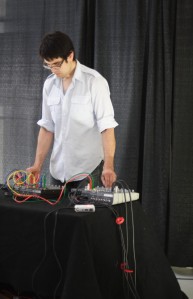Bio
Bio:
Based in Brooklyn, NY, Phillip Stearns is the creator of the Year of the Glitch, a yearlong glitch-a-day project, and Glitch Textiles, a project exploring the intersection of digital art and textile design. He received his MFA in music composition and integrated media from the California Institute of Arts in 2007 and his BS in music technology from the University of Colorado at Denver in 2005.
His work has been exhibited internationally at electronics arts festivals, museums, and galleries including: Turku Biennial 2013, WRO Biennale 2013, Transmediale 2013, Denver Art Museum (2013), The Photographer’s Gallery London (2012), The Camera Club of New York (2012), Eyebeam (2012, 2007), Harvestworks (2010, 2012); Gli.tc/H 2112; Festival De Arte Digital 2010; FILE 2009; NIME 2009; Filmer La Musique 2009; FONLAD 2009; Torrance Art Museum (2008, 2007); Optica Film Festival & (2011 2008). He has participated in residencies at the Making Lab of the 4th APAP ( Korea 2013), Textielmuseum in Tilburg, NL (2013), Institute for Electronic Arts (2012, 2013), Museums Quartier (Vienna 2010), STEIM (Amsterdam 2007, 2013), Experimental Television Center (2009), Harvestworks (NY 2010), Free103Point9 (2012). He has presented and led workshops at several international institutions including the Universidad De Chile (Santiago 2013), Santiago Maker Space (2013), Pomona College (2013), Recyclism Hacklab (Dublin 2013), and the Science Gallery (Dublin 2013).
Statement:
Electronic media operate primarily on only two of our senses: sight and hearing. Though I work with media technologies, electronics and electronic media, I tend to focus on condensing these in such a way that the technologies, tools, and media themselves become entangled with what would normally be read as the content or the message. As electronic media (digital or analog), images, video, and sound become reduced to signal—a manifestation of some order defined within a certain system—Light and Sound themselves become raw materials for reconstituting electronic signals back into physiological experience.
Through deconstruction and reconfiguration the technologically mediated environment is approached as an assemblage, where human activity plays a role of equivalent importance to environmental agency. From this perspective, the development and application of our technologies, machines and tools reveals our perceptual biases, desires, dreams and fears—both conscious and unconscious. Cultural values and meaning, then, can be viewed as derivative, shaped by the particular conditions facilitating the distribution of agency through cascading exchanges of mediated interactions.

